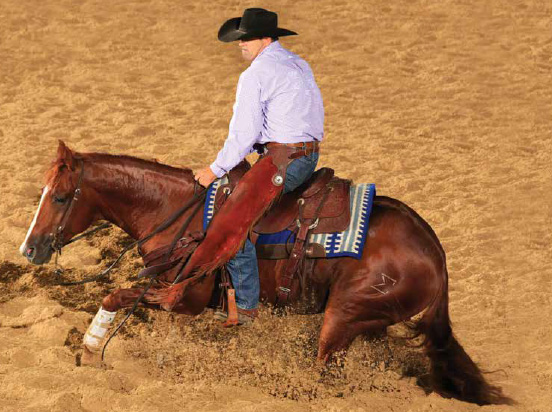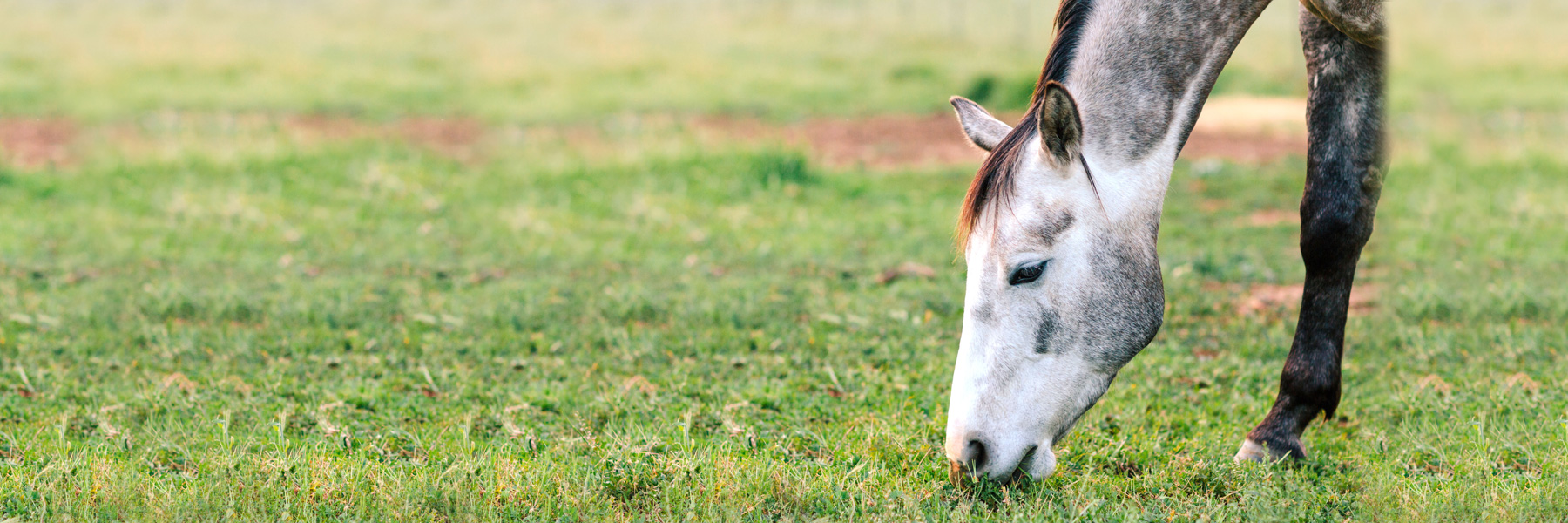Time to Change Traditional Ways of Feeding Your Horse
There are a lot of choices when feeding horses. Chances are that if 100 horse feeders were lined up, there would also be 100 different ways to feed horses. But the best way to fuel a horse may also be the most simple. This is certainly the case for the easy-keeping retirement horse maintained on pasture, but research supports that this also holds true for high performance athletes across the spectrum of the equine industry.
Tradition dictates that the modern domesticated horse needs some longstem fiber source, such as hay for bulk, but that the majority of the “real nutrition” must come from grains, fortified concentrates or complete feeds. However, we now know that the real question is what, if anything, the forage is lacking that needs to be balanced for optimal wellness. Forage as the foundation, or entirety, of the diet is the healthiest feeding choice for horses.
Implementing a Forage-Based Diet
1
Exhaust your forage first — pasture & quality grass hay
2
Use higher-energy forages, such as alfalfa or haylage
3
Balance with a vitamin and mineral supplement
Back to Basics
Change is hard. To feel confident enough to break away from traditional feeding practices, it is necessary to understand how the digestive tract of the horse is specifically designed to operate on a forage-only diet. The horse has evolved as a grazing animal with a specialized gastrointestinal tract that thrives on a diet containing high levels of plant fiber available 24 hours a day. The general digestive tract is analogous to other mammals. The foregut (mouth, esophagus, stomach and small intestine) is responsible for enzymatic digestion. Most sugar, starch, protein and fat digestion, as well as fat-soluble vitamins (A,D, E and K), calcium and phosphorus absorption, takes place in the foregut, primarily in the small intestine. But there is a significant portion of the equine digestive tract that makes it uniquely able to thrive on a continuous high-fiber diet: the hindgut.
The hindgut consists of the cecum, large colon and small colon and makes up over 60% of the total digestive tract, with a capability of holding over 120 quarts of digestive materials. Horses are categorized as hindgut fermenters, meaning that microbial action within the hindgut breaks down the fibers of plant material to be used by the horse for energy and to extract micronutrients or create others, such as the B-vitamins and vitamin K. The hindgut, specifically the cecum and large colon, relies on a beneficial microbial population to ferment and break down high-fiber feed substrates for metabolism. Whereas passage of digesta through the small intestine takes about 60-90 minutes, microbial fermentation is a much slower process. The large size and structure of the cecum and large colon is designed for slow passage of digesta to allow time for the microbes to break down fibrous plant material. Food may take from 36 to 72 hours to pass through the hindgut. Interestingly, the entrance and exit of the cecum are both located at the top of the organ. There must remain enough fibrous fill in the cecum to push digesta out into the large colon for the next stage of digestion. Deprived of the bulk from continuous forage, the many loops of the intestines are more likely to twist or impact. Horses need to be digesting fibrous feeds continually for hindgut health. Since all-day pasture grazing is not always an option, taking steps to allow constant access to forage while penned or stalled can be incredibly beneficial to the horse’s overall health and, in particular, the health of the digestive tract.
Putting the Spotlight Back on Forage
Success With Low Grain/No Grain Feeding Regimens
A common misconception about forage is it will not adequately keep up with the demands, particularly the energy requirements, of working and athletic horses. In fact, the opposite is true. Forage, coupled with the right supplementation, can not only fuel the elite athlete, but it can do so with very low levels of rancidity and oxidative damage when compared with a diet high in grains and concentrates. The following are three horsemen with high-end equine athletes from several different disciplines that have had great success with forage-based, low grain/no grain feeding regimens.
“Good, high quality hay is the key for all horses no matter the job. Using Platinum Performance® Equine for our program is a no-brainer. I am able to feed less because of the high quality ingredients and vitamins. A diet like this with hay and Platinum is simple and easy to balance, and it’s easy to adjust for the different horses’ needs. I don’t have to worry about the quality and questionable levels of vitamins coming from processed feeds. This diet works for us. We base our diet on forage, and our horses look and feel great. It’s just a home run.”
— Randi Goulding, Manager, Green River Farm since 2004

Samba’s Secret owned by Jennifer Smith and ridden by Colin Syquia. PHOTO BY THIERRY BILLET, SPORTFOT PHOTOGRAPHY
Did You Know?
Food may take from 36 to 72 hours to pass through the hindgut.
The ABCs (and VFAs) of Fermentation
The hindgut is alive and teeming with microorganisms including billions of bacteria, protozoa and other strains that are capable of producing the enzymes necessary to break down plant fiber and form the short-chained volatile fatty acids (VFAs) — acetate, propionate and butyrate. The beneficial microbes, also called microflora, or “good” bacteria, are complex and highly developed to process and absorb the ingested plant components that are unable to be digested by the small intestine. The VFAs are absorbed and enter into the bloodstream where they are metabolized within the cells to provide energy for the horse. Acetate and butyrate are immediately available for energy metabolism, and propionate will be converted to glucose before it can be metabolized for energy. This is the remarkable way that horses derive calories from hay and pasture and provides itself with 50% or more of the horse’s total energy intake. The significant contribution of energy from the VFAs is a main reason that forage is pivotal as the basis of the equine diet. These fermentative microorganisms uniquely allow horses to utilize parts of the plant that humans, dogs, cats and other non-hindgut fermenters are unable to use. This is of utmost importance to the horse and only functions properly and efficiently with a slow trickle of high-fiber feed substrates constantly available.
“We’ve got this whole thing backwards. The real question is not about what the grain is providing, but rather what, if anything, the forage is lacking that needs to be filled in to balance a diet.”
Emily Smith, MS, Platinum Performance® Equine Nutritionist
The health of the hindgut microbes is absolutely essential to the well being of the horse. The amount and proportion produced can be altered by composition of the diet, which makes it critical to make diet adjustments slowly. The microbial population is highly dynamic with multi-species interaction. On high-forage diets, specific fiber-fermenting microbe species dominate. When lower forage is fed and a higher ration of grains or concentrates takes its place, the microbes that consume concentrates will be higher. The problem with this is that the actual individual VFAs being produced are in a different ratio that decreases the overall energy available to the horse. The microbes are able to adapt in some regard to the diet, albeit slowly, which is a main reason horses are likely to have colic issues with sudden feed changes.
Equines have the same basic dietary requirements that all animals do — water, protein, carbohydrates, fats, vitamins and minerals. In the amazing fermentation station that is the hindgut, the horse can masterfully utilize forage to extract nutrients, create vitamins and actually make energy. Forage includes high-fiber feeds, which usually have at least 18% total fiber. Forage always has been and should be the staple of the horse’s diet, and it is actually the main source of carbohydrates and energy, protein, vitamins and minerals. Grains usually receive the glory of having energy and carbohydrates to fuel the horse, but forage contains plenty of these carbohydrates as well. Sugars, starch, fructans and predominantly fiber are all present in forage and in a much healthier and safer ratio for horses than grains. Often overlooked by horsemen today is that the equine digestive tract is designed to allow the horse to ingest large quantities of fiber continuously. The horse has an innate need to chew long-stemmed roughage and requires a minimum of 1% of its body weight daily of high-fiber feeds to allow for normal motility of the digestive tract. The digestive tract relies on a steady flow of forage and simply does not function properly without it.
K.I.S.S. Nutrition (Keep It Simple Seabiscuit!)
Steps for Implementing a Forage-Based Diet:
Exhaust your forage first. Use pasture grass or a good quality grass hay or grass hay blend as your foundation.
Use higher-energy forages, such as alfalfa or haylage. Try an oil if your horse requires more energy or to facilitate weight gain. Implementing a “super fiber” like unmolassed shredded or pelleted beet pulp can be an excellent addition for high-fiber and calories.
Balance the forage-based diet with a vitamin and mineral supplement with omega-3 fatty acids and antioxidants, such as Platinum Performance® Equine.
The Trouble with Grain
Grains are typically considered the straight grain itself without fortification. For instance, whole oats, barley, cracked corn, etc. are all grains. Grains are used within concentrates and complete feeds that are usually fortified with vitamins and minerals. High-grain equine diets are associated with several health concerns and inflammatory conditions, including colic, diarrhea, gastric ulcers, developmental orthopedic disease, allergies, laminitis, obesity and insulin resistance simply because the horse’s digestive system is not naturally designed to support a diet high in grain. This traditional way of feeding with heavy-handed grain rations has come with a heavy price in terms of equine health. Many equine health issues are related to current feeding management. The small capacity of the foregut is ill-suited for large, single grain-based meals, particularly with the high level of soluble carbohydrates prominently found in grains. When the relatively small volume of the stomach is overwhelmed from a grain meal, the digesta is quickly pushed into the small intestine. The small intestine is unable to adequately absorb the digestive contents because more continues to pour in. Excess starch spills into the cecum where it is fermented into VFAs, but lactic acid is also formed. Lactic acid can quickly lower the pH of the hindgut where all of the beneficial microbes live. Cecal acidosis will destroy the beneficial microbes and can irritate or actually damage the gut wall. The toxins from dying bacteria can enter the bloodstream and cause laminitis or colic. This is known as carbohydrate overload and is a major reason that maintaining the integrity and balance of the hindgut is so critical, thus highlighting the importance of feeding the horse the way it is designed to be fed.
Aside from the digestive problems and high levels of starches and sugars in general, grains and concentrates pose other problems. It can be difficult to get a firm idea of levels in a feed as the mandatory guaranteed analysis does not have to list all ingredients or levels of ingredients. There is also a risk of cross contamination in mills that make feeds for other species. This can be concerning, especially for equine athletes who must adhere to strict regulations for banned substances. Each year, there are several recalled feeds for banned substances due to cross contamination. In addition, high-heat milling processes, such as pelletization used to formulate feeds damage and denature many of the delicate ingredients, including omega-3 fatty acids. Heat-sensitive vitamins may be damaged or destroyed and levels skewed. Additionally, the level of rancidity and oxidation, particularly in high-fat feeds can be staggering even in a name-brand bag of feed. Oxidative stress due to rancid feeds can be a big problem for all horses but specially for stressed horses, whether from illness, travel or intense exercise, which may be dealing with elevated levels of free radicals and oxidative stress anyways.
There are circumstances where grains, concentrates or complete feeds may be useful. This includes some of the most nutrient-demanding of all ages and stages of horses, including race horses, the growing foal, the late pregnant mare, lactating broodmares and athletes. They should be used as a dietary tool once forage is exhausted and not be confused as a mandatory part of the equine diet. Good quality forage and supplementation to balance any lacking nutrients is the best and most simple way to feed all horses.
Forage-Diet Studies
Race Horses on Forage-Only Diet
Ringmark, S, Revold, T, Jansson A. Animal. 2017.
Summary: Racing is one of the most high-energy disciplines of the equine industry. The traditional race horse diet consists of a high consumption of energy-dense concentrates. Forage-only diets can keep up with energy demands of intense training.
Results: Forage-only diet did not impair performance. The forage-only diet did not inhibit growth, body condition score or muscle glycogen storage — a measure of muscle energy storage. Horses did not develop nutrition-related disorders or stereotypes.
Horses in Training on Forage-Only Diet
Jansson A, Lindberg JE. Animal. 2012.
Summary: Horses in training were fed either a forage-only diet or a diet of 50% forage and 50% concentrate for comparison of metabolic responses.
Results: Body condition was unaffected by diet. Heart rate, breathing frequency and rectal temperature were not different between either group. Concentrations of lactate in the blood were significantly lower in the forage-only group that may indicate a greater capacity for exercise as muscle lactate increases muscle acidity and causes fatigue. Also suggested that aerobic energy utilization was improved on forage-only diet. Energy usage efficiencies were the same in both diets.
Performance Horses and Low Colic Risk on Forage-Only Diet
Ringmark S. Doctoral Thesis. Acta Universitatis Agriculturae Sueciae. 2014.
Summary: Performance horses in training on high-energy forage-only diet were tracked for 2.5 years from 18 months to 4 years old. No colic cases were seen during normal management routines.
Results: Lack of colic cases may indicate that high-energy forage-only diets might be a healthy alternative to high-concentrate diets for performance horses.
Broodmares on Free-Choice Forage have Higher Conception Rates
Benhajali, H., M. Ezzaouia, C. Lunel, et. Al. 2013. PLoS One.
Summary: Broodmare groups fed roughage day and night were compared to those fed at night only. Both mares were fed the same amount in a 24-hour period.
Results: The broodmares with more access to forage had significantly fewer estrus abnormalities as well as significantly higher conception rates.
Young Horses on Forage-Only Diet
Ringmark S, Roepstorff L, Essen-Gustavsson B., Revold T, Lindhom A, Hedenstrom U, Rundgren M, Ogren G, Jansson A. Animal. 2013.
Summary: Yearlings on forage-only diet were tracked to monitor body condition, height, heart rate post-exercise and general health scores by independent veterinarian.
Results: Yearlings in training fed free-choice high-energy forage are able to reach a conventional training rate and grow at the same rate compared to yearlings of other light breeds.
Keeping It Real
The horse is different. Horses are not meal eaters; they are constant eaters. They are not grain eaters; they are fiber foragers. They are certainly doing activities, such as sprinting and jumping and cutting and pirouetting that they would not normally be doing often as wild horses. But a common misconception about forage is that it will not supply enough to keep up with nutrient demands, particularly energy requirements of working and athletic horses. However, due to their capacity for hindgut fermentation, horses are set up in a way to maximize the extraction of nutrients from the large quantities of forage that they consume daily. Because tradition suggests that horses need to be fed diets that contain high levels of grains, concentrates or complete feeds in an attempt to maximize growth or athleticism, the abundant contribution of forage is detrimentally overshadowed.
Change is hard. Changing tradition is even harder. But hardest of all may be going against nature’s perfect design, as evidenced by the plethora of manmade grain-associated equine diseases that are ever-increasing in current conversation. Mother Nature will always put up a fight, and it is best to work with her rather than against her. As champions of the horse, this fundamental problem must be addressed for the health and love of the animal. As veterinarians, trainers, riders, managers, grooms, owners and as horse lovers from all walks of the equestrian life: be the change.
A Challenge to You
Switch to a forage-based or forage-only diet and supplement with Platinum Performance® Equine to reap the benefits of a natural diet for your horse.
Platinum Performance® Equine was veterinarian formulated to complement a forage-based diet and fill in common nutritional gaps seen in a modern natural diet.
Discover all the ways Platinum and forage can fuel your horse to his full potential.
60% of the total digestive tract the hindgut makes up, consisting of the cecum, large colon and small colon, with a capability of holding over 120 quarts of digestive materials.


by Emily Smith, MS,
Platinum Performance®
